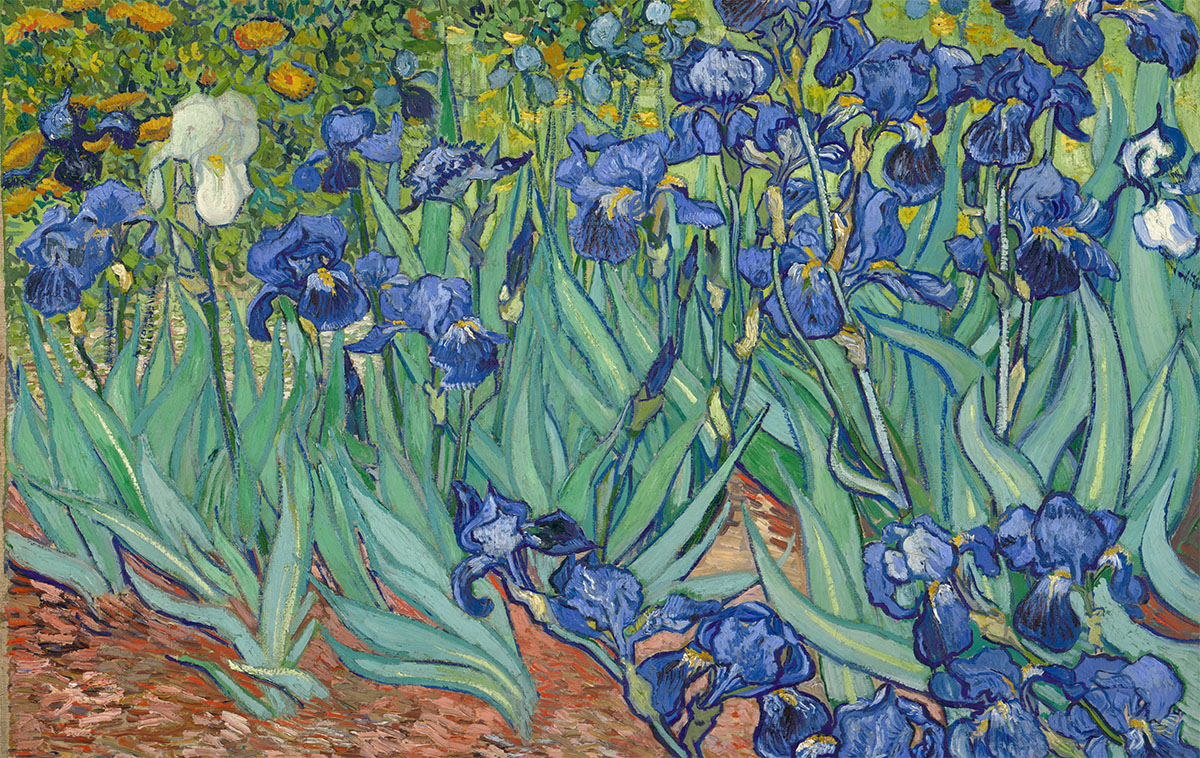
Louisiana Irises: Living Art From Our Own Backyard
Bold
Colorful
Native
Pollinator-Friendly
Easy-To-Grow
Diverse
Collectible
1. The rainbow of color choices provides you with limitless options in your garden. You can match an existing color scheme, you can choose colors that contrast with your existing garden colors, or you can mix them all for a kaleidoscopic bouquet of every hue!
2. Growing them at home helps to preserve the genetic diversity of these amazing native plants. Their wetland habitats have been shrinking for decades, and gardeners can play an important role by preserving them in gardens.
3. You are likely to have success with these perennials because they are easy-to-grow. Most plantings will grow and multiply so that you can even divide the plants and share them with friends, or spread them around to more parts of your own yard.
4. A homegrown arrangement, with greenery from the garden and a few Louisiana Iris flowers is a stunning and special gift for loved ones. The sturdy bloom stalks and bold flowers make excellent cut flowers.
5. Pollinators love these showy blooms as much as people do. You’ll feed hungry bees with each colorful flower.

In the wild, these native irises are usually found in wet areas. They thrive along the edge of ponds, streams, or lakes where there is constant moisture. They can even live in 2”-3” of water. However, they don’t have to be in soaking wet conditions all the time.
Their preference for wet conditions allows them to grow in poorly drained soil like clay.
They will grow happily in rich garden soil with the rest of your flowers.
Be sure to apply a thick layer of any organic mulch (leaves, pinestraw, bark, wood chips) around the plants to help keep their roots moist between waterings.
Sandy or dry conditions will be a struggle and should be avoided.
Fertilize in October and February to produce the strongest plants and the most abundant flowers.
After the blooms finish, cut the flower stalk where it emerges from the leaves and remove it to the compost pile. Pollinators do such a good job fertilizing the blooms that they generally set heavy crops of seeds. Producing all those seeds takes a lot of energy, and the plants will grow stronger and produce more flowers next year if the stalks are removed before the seeds are formed.
Vigorous plants will produce full clumps of lush foliage in just a few years. You may see the thick roots climbing on top of each other near the surface of the soil. Feel free to divide these clumps every 2-3 years. Simply dig the plants up in early fall, pull apart the thick roots, called rhizomes, and replant them. Space the rhizomes farther apart so they have more room to grow. This allows you to increase the size of your planting, start a new planting, or share them with friends!
Dividing the roots of one plant will produce more copies of that same plant. If you want to keep track of your irises, be sure to maintain space between each variety so you know which ones you are working with. Plantings of densely mixed varieties are beautiful when in bloom, but it becomes nearly impossible to extract specific varieties from the mix at division time.
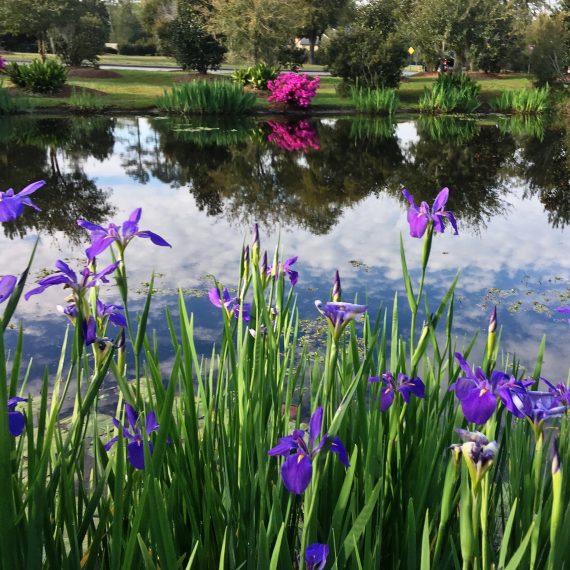
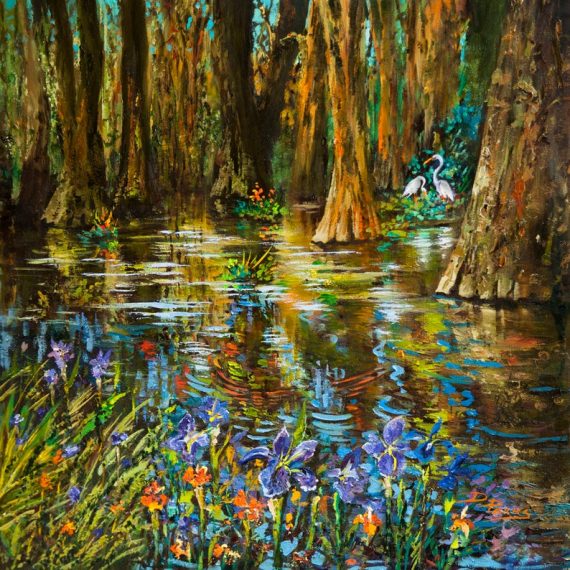
Louisiana Irises are perennial plants with an unusual trait; they grow in the fall and winter, bloom in the spring, and lie dormant in the summer months. This is quite the opposite of most perennials who are active during the hot summer and disappear during winter. This rare trait is one of their greatest design assets. Carefully arranging them with compatible partners can help keep a flower bed full and pretty all year long.
Cottage Style
A cottage garden is essentially a mix of many different kinds of flowering annuals and perennials. I love these gardens, where there are no rules, where you are free to plant whatever strikes your fancy. Over time the strong plants thrive and spread while the weak are removed. A cottage garden is always changing and evolving. Since most perennials are dormant in the winter, a cottage garden can look down right empty during the cool season. Many perennials don’t put on a good show until summer or fall, so a cottage garden can be slow to get showy in the spring. Louisiana Irises can help with both problems. Their lush, upright, strappy foliage is at its best during the winter, and they bloom heavily in March and April when most other perennials are just starting to regrow. Consider adding clumps of Louisiana Irises throughout your entire perennial beds. They’ll be covered up by the other perennials in summer and fall, but they’ll take the lead for winter and spring. It’s a perfect perennial pairing!
Pond Accent
Louisiana Irises are an essential pond accessory. This one is simple, if you have a pond, you need these irises. They will grow without any care or effort around the edge of the water, softening the transition from water to land, preventing erosion of the banks, filtering runoff as it enters the pond, and they’ll create glowing gemstone-like blooms that reflect in the water. Ponds love irises!
The Border
The strappy, upright leaves of irises make a lovely border when planted in a dense line. Here again, you should plan for their summer dormancy. Use Louisiana Irises as part of a layered border. Shorter, evergreen border grass, like Liriope, can form the first layer. Plant a single strip of ‘Super Blue’ or Emerald Goddess’ with a wider strip of irises behind it. The dark green border grass will hide the irises when they are not showy in the summer, and the bold iris foliage and flowers will rise up above the Liriope in the fall, winter, and spring.
A mixed border is another option. Interplant a mix of grassy plants like Daylily, Liriope, Agapanthus, African Iris, and Louisiana Iris for a border that has something to offer all year long. A mixed border imparts an informal feel to the landscape, which can be balanced by placing a large uniform planting just behind the mixed border. A well-kept swoop of evergreen azaleas or camellias would form the perfect backdrop for a mixed flowering perennial border.
A Dedicated Space
If you fall in love with Louisiana Irises, which would be perfectly understandable, consider dedicating part of the yard to growing them by themselves. Planted in long rows like vegetable crops, or in a series of small beds, these blocks of color will amaze your guests. A dedicated space is perfect for the gardener who wants to collect and share as many varieties as possible, as the organization makes it easy to keep track of each cultivar. Florists would also love this layout, as the dedicated cultivation allows for the production of the most blooms.
To Stand Alone or Mingle?
A final design consideration, no matter how you arrange your irises, is whether to mix colors or to plant solid blocks of the same color.
A large swath of one single variety will create the greatest visual impact, it is the most bold display, and it is the best way to catch the eye from a distance. However, the display won’t last as long as a mix and it lacks interest up close.
A mix of varieties that are of a similar color, yet each unique, will provide a medium impact from a distance, while extending the blooms season of the display. Variations of one color, mixed together, create a calming effect on the viewer, and it offers greater interest than a single variety when viewed up close.
A mix of all different colors offers the greatest interest for garden visitors and it produces the longest window of blooms, but it will lack visual impact from a distance.
Each option has pros and cons, and none should be viewed as “right” or “wrong”. Choose the style that best suits your intentions and personal aesthetics.
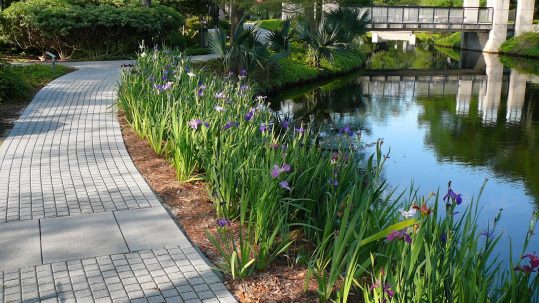
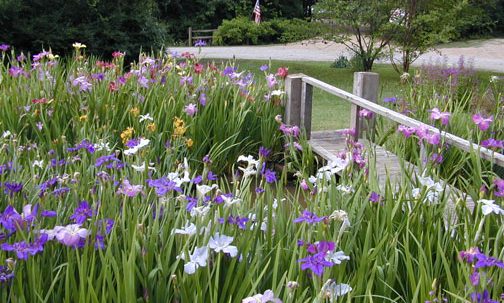
Louisiana Irises represent a huge group of plants that consists of 5 wild species of irises and all the hybrids formed by cross-pollinating those species with one another. Most of these species are found all over the Gulf Coast region of the Southeastern United States, with 4 of them naturally found in Florida! They are named after Louisiana because that is the state with the highest concentration of the wild species, and thus the largest number of naturally occurring hybrids as well. For all the plant geeks out there, the 5 species are Iris nelsonii, Iris fulva, Iris giganticaerulea, Iris hexagona, and Iris brevicaulis.
Even in the wild, these species have a great degree of variation in bloom color and size. When the bees get to work cross-pollinating those species, the diversity of flowers explodes. Then gardeners make even more crosses, and you end up with the hundreds of Louisiana Iris varieties that exist today.
Despite all the variety, most of the plants have similar growth characteristics. Most grow 2’-3’ tall with flowers that rise above the foliage, they grow from fall-winter, they bloom in the spring, they all tolerate wet soil but also thrive in rich garden soil.
They like the same acidic soil preferred by camellias and azaleas, just look for those plants to confirm your soil is appropriate.
If you allow your plants to set seed, those seeds will each produce genetically unique offspring. Most will be average, but some might be so spectacular they become a new named variety! Just keep in mind, a bunch of seedlings coming up in the garden will make it hard to keep your other varieties organized.
Tallahassee Nurseries is excited to have a lovely selection of Louisiana Irises to offer for Spring 2021. These plants are a seasonal item, so shop soon, they won’t be restocked until next winter!
<pictorial guide, include their names and the pics pretty big in a grid or collage. There’s a few I don’t have pictures of so please add “And even more to choose from at the nursery!” after the pics>
Louisiana Iris Varieties In stock as of 3.4.2021
(Shop soon, these plants always sell out fast and they won’t be restocked until next year.
For day-to-day stock info, feel free to email or call us. 850-385-2162)
• Iris – Ann Chowning
• Iris – Beale Street
• Iris – Blue Flag
• Iris – Fortune Finder
• Iris – Fulva (Copper Iris)
• Iris – Giant Blue Iris
• Iris – Jeri
• Iris – Laura Louise
• Iris – Peaches in Wine
• Iris – Red Velvet Elvis
• Iris – Wow Factor
*This article was written by Jonathan Burns (Tallahassee Nurseries Outdoor Manager, FNGLA Florida Certified Horticulture Professional) informed by years of personal observations growing in the Tallahassee area.

